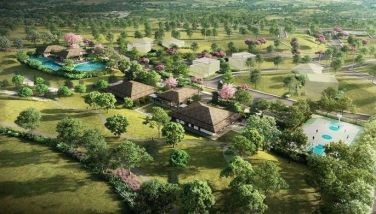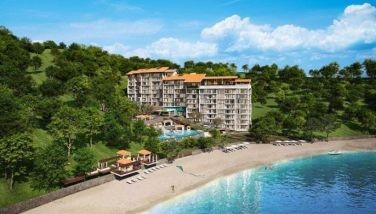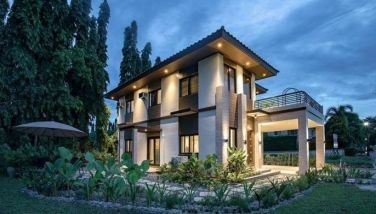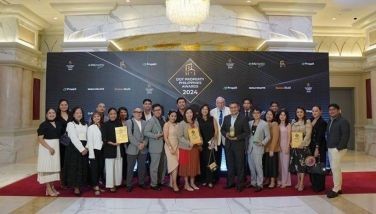Government housing benefits from sludge
April 27, 2002 | 12:00am
LOS BAÑOS, Laguna – The government’s housing program can benefit considerably from an award-winning technology using cement-bonded boards (CBB) made from paper mill solid wastes (sludge) as construction materials.
The cement-bonded sludge board (CBSB) technology was developed by a team of researchers from the University of the Philippines Los Baños-College of Forestry and Natural Resources (UPLB-CFNR).
The technology is a product of a project funded by the Department of Science and Technology-Philippine Council for Industry and Energy Research and Development (DOST-PCIERD) conducted by Dr. Elvira C. Fernandez (team leader), Dr. Margaret Calderon, Engr. Teodulfo Delgado, and Cleven Reyve Lamason.
It won first prize in the Outstanding R&D in Industry and Energy-Year 2002 Regional Competition, Non-NCR (National Capital Region) held last March 2 under the sponsorship of DOST-PCIERD. It subsequently placed second in the national S&T Fora and Competition held last March 26.
The project was implemented with the Trust International Paper Corp. (TIPCO) in Mabalacat, Pampanga, as the private cooperator. Also involved was the UPLB Foundation, Inc.
Sludge, or fiber clay, is the final solid waste or residue recovered after the treatment of paper mill effluent (wastewater).
The CBBs made from these residues are good materials for interior and exterior walls, partitions, and ceilings, as exemplified by the model house constructed within the TIPCO complex in Mabalacat.
Portland cement to fiber clay ratio of 60:40, 50:50, and 40:60 were used to produce boards of different thickness (six millimeters, 12 mm, 18 mm).
Calcium chloride, sodium silicate, aluminum sulfate, and china clay were added to accelerate curing and hardening of the boards.
Results showed that the 60:40 board had the highest strength, the researchers reported in a paper titled "Alternative Construction Material from a Recycling Paper Mill Sludge."
"Our findings suggest that cement boards manufactured from sludge as reinforcement have mechanical and physical properties comparable to those of other cement-bonded boards manufactured in the Philippines," they said.
Tests conducted also showed that the CBSB was fire-resistant, had sound proofing and acoustical property, and highly resistant to subterranean and drywood termites after four months of tests.
They added that the proposed pilot plant for the production of CBB from sludge has been found feasible in a market feasibility study done.
"The projected market demand for panel boards in the next 10 years far exceeds the projected supply, indicating the excellent market potential of cement-bonded boards," they further reported.
The product can be priced competitively because of low production cost (the pilot houses at TIPCO costs only P185,000).
The UPLB-CFNR researchers said the primary target clientele of the cement-bonded sludge board is the low-cost housing sector, particularly the projects under the National Housing Authority (NHA).
At present, they noted, NHA makes heavy use of hollow blocks, prefabricated modular components or panels, and other materials for its housing projects.
A total of 118,698 dwelling units are needed every year in the rural areas and 131,282 units in urban areas, NHA records show.
The cement-bonded sludge board (CBSB) technology was developed by a team of researchers from the University of the Philippines Los Baños-College of Forestry and Natural Resources (UPLB-CFNR).
The technology is a product of a project funded by the Department of Science and Technology-Philippine Council for Industry and Energy Research and Development (DOST-PCIERD) conducted by Dr. Elvira C. Fernandez (team leader), Dr. Margaret Calderon, Engr. Teodulfo Delgado, and Cleven Reyve Lamason.
It won first prize in the Outstanding R&D in Industry and Energy-Year 2002 Regional Competition, Non-NCR (National Capital Region) held last March 2 under the sponsorship of DOST-PCIERD. It subsequently placed second in the national S&T Fora and Competition held last March 26.
The project was implemented with the Trust International Paper Corp. (TIPCO) in Mabalacat, Pampanga, as the private cooperator. Also involved was the UPLB Foundation, Inc.
Sludge, or fiber clay, is the final solid waste or residue recovered after the treatment of paper mill effluent (wastewater).
The CBBs made from these residues are good materials for interior and exterior walls, partitions, and ceilings, as exemplified by the model house constructed within the TIPCO complex in Mabalacat.
Portland cement to fiber clay ratio of 60:40, 50:50, and 40:60 were used to produce boards of different thickness (six millimeters, 12 mm, 18 mm).
Calcium chloride, sodium silicate, aluminum sulfate, and china clay were added to accelerate curing and hardening of the boards.
Results showed that the 60:40 board had the highest strength, the researchers reported in a paper titled "Alternative Construction Material from a Recycling Paper Mill Sludge."
"Our findings suggest that cement boards manufactured from sludge as reinforcement have mechanical and physical properties comparable to those of other cement-bonded boards manufactured in the Philippines," they said.
Tests conducted also showed that the CBSB was fire-resistant, had sound proofing and acoustical property, and highly resistant to subterranean and drywood termites after four months of tests.
They added that the proposed pilot plant for the production of CBB from sludge has been found feasible in a market feasibility study done.
"The projected market demand for panel boards in the next 10 years far exceeds the projected supply, indicating the excellent market potential of cement-bonded boards," they further reported.
The product can be priced competitively because of low production cost (the pilot houses at TIPCO costs only P185,000).
The UPLB-CFNR researchers said the primary target clientele of the cement-bonded sludge board is the low-cost housing sector, particularly the projects under the National Housing Authority (NHA).
At present, they noted, NHA makes heavy use of hollow blocks, prefabricated modular components or panels, and other materials for its housing projects.
A total of 118,698 dwelling units are needed every year in the rural areas and 131,282 units in urban areas, NHA records show.
BrandSpace Articles
<
>
- Latest
Latest
Latest
October 23, 2024 - 9:30am
By May Dedicatoria | October 23, 2024 - 9:30am
October 11, 2024 - 3:45pm
October 11, 2024 - 3:45pm
October 10, 2024 - 11:30am
October 10, 2024 - 11:30am
October 5, 2024 - 12:08pm
October 5, 2024 - 12:08pm
September 24, 2024 - 1:00pm
September 24, 2024 - 1:00pm
September 13, 2024 - 4:00pm
September 13, 2024 - 4:00pm
Recommended






























